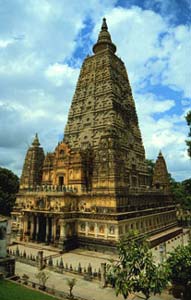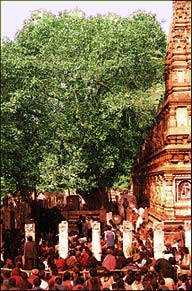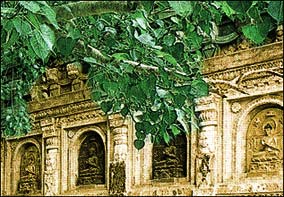As Gautama sat in deep meditation,
Mara, Lord of Illusion, perceiving that his power was about
to be broken, rushed to distract him from his purpose. The
Bodhisattva touched the earth, calling it to bear witness
the countless lifetimes of virtue that had led him to this
place of enlightenment. When the earth shook, confirming the
truth of Gautama's words, Mara unleashed his army of demons.
In the epic battle that ensued, Gautama's wisdom broke through
the illusions and the power of his compassion transformed
the demons' weapons into flowers and Mara and all his forces
fled in disarray.

The Maha Bodhi
Temple
 The
historical place at which the Enlightenment took place became
a place of pilgrimage. Though it is not mentioned in the scriptures,
the Buddha must have visited Bodh Gaya again in the course
of his teaching career. About 250 years after the Enlightenment,
the Buddhist Emperor, Ashoka visited the site and is considered
the founder of the Mahabodhi Temple. According to the tradition,
Ashoka, as well as establishing a monastery, erected a diamond
throne shrine at this spot with a canopy supported by four
pillars over a stone representation of the Vajrasana, the
Seat of Enlightenment.
The
historical place at which the Enlightenment took place became
a place of pilgrimage. Though it is not mentioned in the scriptures,
the Buddha must have visited Bodh Gaya again in the course
of his teaching career. About 250 years after the Enlightenment,
the Buddhist Emperor, Ashoka visited the site and is considered
the founder of the Mahabodhi Temple. According to the tradition,
Ashoka, as well as establishing a monastery, erected a diamond
throne shrine at this spot with a canopy supported by four
pillars over a stone representation of the Vajrasana, the
Seat of Enlightenment.
The temple's architecture is
superb but its history is shrouded in obscurity. It was constructed
with the main intention of making it a monument and not a
receptacle for the relics of the Buddha. Several shrines were
constructed with enshrined images for use as places of worship.
The basement of the present temple
is 15m square, 15m in length as well as in breadth and its
height is 52m which rises in the form of a slender pyramid
tapering off from a square platform. On its four corners four
towers gracefully rise to some height. The whole architectural
plan gives pose and balance to the observers.
Inside the temple there is a
colossal image of the Buddha in the "touching the ground
pose", bhumisparsha mudra. This image is said to be 1700
years old and is facing east exactly at the place where the
Buddha in meditation with his back to the Bodhi tree was enlightened.
The Bodhi Tree
 For seven days after the Enlightenment, the Buddha continued
to meditate under the Bodhi tree without moving from his seat.
During the second week he practiced walking meditation. A
jewel walk, Chankramanar, was built as a low platform adorned
with nineteen lotuses which are parallel to the Maha Bodhi
temple on its north side. For another week the Buddha contemplated
the Bodhi tree. In this place a stupa was built called Animeschalochana
situated to the north of the Chankramanar.
For seven days after the Enlightenment, the Buddha continued
to meditate under the Bodhi tree without moving from his seat.
During the second week he practiced walking meditation. A
jewel walk, Chankramanar, was built as a low platform adorned
with nineteen lotuses which are parallel to the Maha Bodhi
temple on its north side. For another week the Buddha contemplated
the Bodhi tree. In this place a stupa was built called Animeschalochana
situated to the north of the Chankramanar.
On the back of the main temple
situated to the west (see picture) there is an ancient pipal
tree Ficus religiosa or Bodhi tree. It was under this tree
that Gautama sat for enlightenment. The present tree is considered
only as the descendant of the original tree. There is a tradition
that Ashoka's wife had it secretly cut down because she became
jealous of the time Ashoka spent there. But it grew again
and a protective wall was also built at the time. Many sacred
trees in India and other countries are originally raised from
seeds brought from the ancient Bodh Gaya tree. A shoot of
the original Bodhi tree was taken to Sri Lanka in the 3rd
century B.C. by Bhikkhuni Sangamitta, daughter of Ashoka,
where the Lankan king Devanampiyatissa planted it at the Mahavihara
monastery in Anuradhapura where it still flourishes today.
While the Vajrasana was the specific site of the enlightenment,
the Bodhi tree, closely linked to the Buddha's accomplishment,
became a central focus of devotion early in the history of
the Sangha. Pilgrims sought the Bodhi Tree's seeds and leaves
as blessings for their monasteries and homes.
Around the Bodhi tree and the
Mahbodhi temple there are quadrangular stone railings around
0.2m high with four bars including the top piece. These are
of two types and can be distinguished from each other in style
and material used. The older set is dated to about 150 BC
and made of sandstone while the latter set is probably of
the Gupta period (300-600 AD) and constructed from course
granite. The older set has a number of designs representing
scenes from the purchase of Jetavana by Ananthapindika at
Sravasti, Lakshmi being bathed by elephants, Surya riding
a chariot drawn by four horses, etc. On the latter set there
are figures of stupas, Garudas, etc. In most of these railings
lotus motifs are commonly used.
Bodhgaya
Revitalised
 Since
1953, Bodh Gaya has been developed as an international place
of pilgrimage. Buddhists from Sri Lanka, Thailand, Burma,
Tibet, Bhutan and Japan have established monasteries and temples
within easy walking distance of the Mahabodhi compound. The
site of the enlightenment now attracts Buddhists and tourists
from all over the world.
Since
1953, Bodh Gaya has been developed as an international place
of pilgrimage. Buddhists from Sri Lanka, Thailand, Burma,
Tibet, Bhutan and Japan have established monasteries and temples
within easy walking distance of the Mahabodhi compound. The
site of the enlightenment now attracts Buddhists and tourists
from all over the world.
At any time during the cooler
months between December and March, a visitor to Bodh Gaya
can observe a continual stream of Indian and international
pilgrims walking the roads or arriving in buses, circumambulating
the temple, performing prostrations and offering prayers in
a multitude of languages. For those who aspire to awaken their
full potential, Bodh Gaya today is truly a field vibrant with
the potentiality of enlightenment. Enriched by devotion of
Buddhists of all traditions, this holy site is emerging as
a powerful inspiration to the modern world, awakening people
of all nations to the real possibility of enlightenment.
